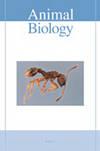人为干扰改变了墨西哥南部热带森林中哺乳动物和水果之间的相互作用
IF 0.9
4区 生物学
Q2 ZOOLOGY
引用次数: 0
摘要
对热带哺乳动物退化的研究强调了物种的丧失及其数量和多样性的减少;然而,与这种人为破坏相关的一系列复杂影响,包括耐受干扰的哺乳动物相对丰度的增加,以及外来哺乳动物的到来,这些动物对生物相互作用的影响尚未得到充分研究。我们比较了墨西哥南部韦拉克鲁斯Los Tuxtlas野外站(LTFS)内外的森林地面上食用鸭嘴兽果实的哺乳动物的物种丰富度、组成、相互作用强度和日常活动模式。利用相机陷阱,我们记录了8种哺乳动物在LTFS内(树)与果实的相互作用,9种哺乳动物在LTFS外(树)与果实的相互作用。外来物种如狼犬(Canis lupus familiaris)在LTFS内外均有记录,而牛头犬(Bos taurus)仅在LTFS外有记录。中等大小的多能哺乳动物在LTFS内和LTFS外都有过多的代表,这表明与在更完整的森林中与P. sapota果实相互作用的哺乳动物组合相比,动物群的贫困化。与桃果有强烈相互作用的哺乳动物的日常活动模式在LTFS内和LTFS外是不同的,尤其是小鹿。我们的研究结果表明,人类活动的影响是高度普遍的,直接影响着不同层次的哺乳动物,间接影响着这些动物所参与的生物相互作用。本文章由计算机程序翻译,如有差异,请以英文原文为准。
Anthropogenic perturbation modifies interactions between mammals and fruits in a tropical forest of southern Mexico
Studies of tropical mammal defaunation highlight the loss of species as well as their reduction in abundance and diversity; however, there is a complex series of effects associated with this anthropogenic disruption, including increases in the relative abundance of disturbance-tolerant mammals and the arrival of alien mammals whose effects on biotic interactions have been poorly studied. We compared the species richness, composition, interaction strength, and patterns of daily activity of mammals that consume the fruits of Pouteria sapota on the forest floor, both inside and outside of the Los Tuxtlas Field Station (LTFS) in Veracruz, southern Mexico. Using camera traps, we recorded eight mammal species interacting with the fruits inside the LTFS ( trees) and nine species interacting outside ( trees). Alien species such as Canis lupus familiaris were recorded both inside and outside of the LTFS, whereas Bos taurus was only recorded outside. Medium-sized generalist mammals were overrepresented both inside and outside of the LTFS, evidencing an impoverishment of the fauna, when compared to the mammal assemblage reported to interact with P. sapota fruits in a more intact forest. The daily activity patterns of the mammals that interacted strongly with P. sapota fruits were different inside and outside the LTFS, particularly in the case of Cuniculus paca. Our results show that the impact of human activity is highly pervasive, directly affecting the mammalian fauna at different levels and indirectly affecting the biotic interactions in which these animals are involved.
求助全文
通过发布文献求助,成功后即可免费获取论文全文。
去求助
来源期刊

Animal Biology
生物-动物学
CiteScore
2.10
自引率
0.00%
发文量
34
审稿时长
3 months
期刊介绍:
Animal Biology publishes high quality papers and focuses on integration of the various disciplines within the broad field of zoology. These disciplines include behaviour, developmental biology, ecology, endocrinology, evolutionary biology, genomics, morphology, neurobiology, physiology, systematics and theoretical biology. Purely descriptive papers will not be considered for publication.
Animal Biology is the official journal of the Royal Dutch Zoological Society since its foundation in 1872. The journal was initially called Archives Néerlandaises de Zoologie, which was changed in 1952 to Netherlands Journal of Zoology, the current name was established in 2003.
 求助内容:
求助内容: 应助结果提醒方式:
应助结果提醒方式:


